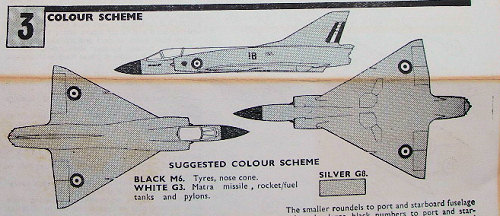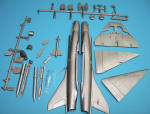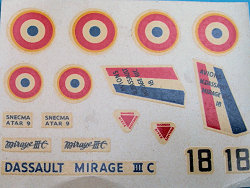
| KIT: | Airfix 1/72 Mirage IIIC |
| KIT #: | 292 (1964) |
| PRICE: | Currently out of production |
| DECALS: | One option |
| REVIEWER: | Victor Scheuerman |
| NOTES: |
Perhaps the first injected molded 1/72 Mirage III. |

| HISTORY |
An all weather interceptor and ground attack aircraft, the Mirage III C is the initial production model of the extremely successful series of Dassault multi-purpose deltas. Some 200 of this particular version have been produced and are in service with the French Armee de L’Air and the Israeli Air Force.
Development of the Mirage stems from a French competition for a light weight day fighter held in 1954. Although nothing came of the competition the Dassault entry showed such promise that a higher powered version, known as the Mirage III was produced and flew in November 1956. In the following January a speed of Mach 1.5 was achieved with the Atar engine and when an auxiliary rocket, the SEPR.66 was fitted this speed was increased to M 1.9. Ten pre-production Mirage IIIA’s were built, the first flying in 1958, and development flying was carried out with these, a speed of Mach 2 being exceeded in October 1958.
The IIIC Mirage is an extremely versatile aircraft, it is fitted with low pressure tyres enabling it to operate from grass air-strips, has a highly efficient Cyrano radar for gun or missile control and navigation, can be fitted with a booster rocket for high altitude missions and is capable of carrying a wide range of underwing stores. External loads can include long range fuel tanks with combined rocket launchers, Matra, Falcon, Sidewinder or Nord guided missiles, conventional or nuclear bombs and a variety of rockets or napalm tanks. Internal armament is a pair of 30 mm. DEFA guns, each with 125 rounds.
Other Mirage versions in service or being introduced include the IIIB a tandem seat trainer; the IIIE long-range strike aircraft; the IIIO which is a variant of the IIIE to be manufactured in Australia for the R.A.A.F.; the IIICZ for the South African Air Force; the IIIR a reconnaissance version and the IIIS for Switzerland.
With over 600 Mirages already ordered or delivered, many of them for export it seems certain that the Mirage III will be a common sight throughout the world for many years to come.
The Mirage IIIC is powered by an Atar turbo jet of 9,600 Ib.s.t (14,110 Ibs s.t. with after burner) giving a maximum speed of approximately Mach. 2.05. Normal armament consists of two 30 mm. DEFA cannon, two JL100 rocket/fuel pods and one Matra guided missile. Wing span is 27 ft. and length 43 ft. 10 ins.
(Thanks to the kit assembly sheet)
| THE KIT |
 Airfix’s ancient Mirage IIIC consists
of 43 individual silver parts with petit raised panel lines and a one-piece
clear canopy. The cockpit detail is limited to a pilot, Martin-Baker seat and
some minor detail on the instrument coaming. Separate intake bullets are glued
from the inside (becomes part of the cockpit sidewall) and the other fuselage
additions are the radome, separate nose probe, lower aft fuselage strake,
fuselage pylon and a two-piece Atar engine afterburner assembly.
Airfix’s ancient Mirage IIIC consists
of 43 individual silver parts with petit raised panel lines and a one-piece
clear canopy. The cockpit detail is limited to a pilot, Martin-Baker seat and
some minor detail on the instrument coaming. Separate intake bullets are glued
from the inside (becomes part of the cockpit sidewall) and the other fuselage
additions are the radome, separate nose probe, lower aft fuselage strake,
fuselage pylon and a two-piece Atar engine afterburner assembly.
While the nose landing gear bay is framed in (too shallow), the main gear wells are not. The landing gear legs themselves are actually rather nice with petit retraction arms and the nose wheel is molded as part of the nose leg. Common for the era are that all the gear doors are too thick.
External stores are limited, though
somewhat exotic. Airfix supplies a single air-to-air Matra R.511
 missile for
the fuselage station. Unfortunately, all the flying surfaces are way too thick
(to be expected for a 1964 mold), lower fin is missing and the fuselage shape is
not correct. The other stores are the air-to-ground Dassault JL-100 combination
rocket pod/fuel tanks for each wing and these look good. All of these stores are
firmly held in place with some rather thick pylons. These pylons and the
separate inner control surface actuators all fit into large receiving slots. One
of the nice things about the wing is that Airfix actually captured the downward
curvature at the wing tips.
missile for
the fuselage station. Unfortunately, all the flying surfaces are way too thick
(to be expected for a 1964 mold), lower fin is missing and the fuselage shape is
not correct. The other stores are the air-to-ground Dassault JL-100 combination
rocket pod/fuel tanks for each wing and these look good. All of these stores are
firmly held in place with some rather thick pylons. These pylons and the
separate inner control surface actuators all fit into large receiving slots. One
of the nice things about the wing is that Airfix actually captured the downward
curvature at the wing tips.
Airfix was not generous with the decal sheet with only one French subject in natural metal finish being offered. This is limited to a black 18 fuselage number and none of those great French unit insignia but with a full-colour rudder. Rather moot points as these are well pass their due date and there are several after market sheets to be had. The decal positions and brief colour notes are included on the one-page, two-step assembly sheet.
| CONCLUSIONS |
Normally this kit would be left in the box, on a shelf in my archives. However, this was a bagged (no box) eBay 99 cent purchase that is missing the pilot, seat and wing control housings. This kit was acquired to be built for nostalgic reasons and to see if I could limit the detailing to the cockpit. I have this ‘issue’ with unframed wheel wells that I really need to get over as I have a few other ‘Golden Oldies’ that have been left because of this. Stay tuned for a quick build that hopefully leaves the gear bays as is!
If you would like your product reviewed fairly and quickly, please contact me or see other details in the Note to Contributors.
September 2007